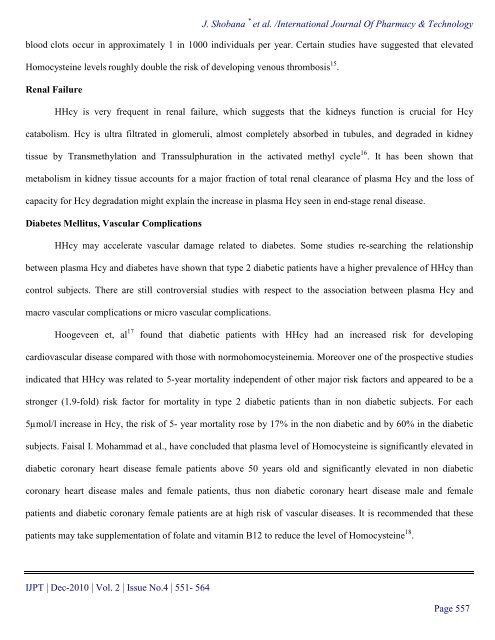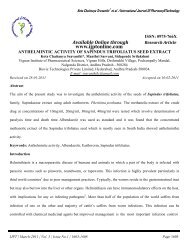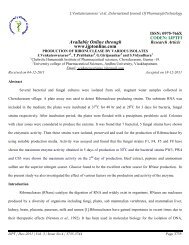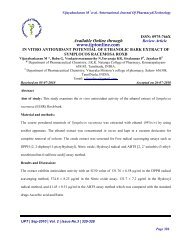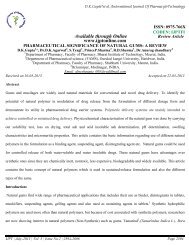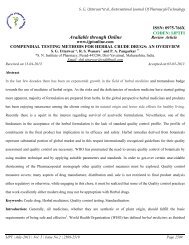Available Online through - International Journal of Pharmacy and ...
Available Online through - International Journal of Pharmacy and ...
Available Online through - International Journal of Pharmacy and ...
You also want an ePaper? Increase the reach of your titles
YUMPU automatically turns print PDFs into web optimized ePapers that Google loves.
J. Shobana * et al. /<strong>International</strong> <strong>Journal</strong> Of <strong>Pharmacy</strong> & Technologyblood clots occur in approximately 1 in 1000 individuals per year. Certain studies have suggested that elevatedHomocysteine levels roughly double the risk <strong>of</strong> developing venous thrombosis 15 .Renal FailureHHcy is very frequent in renal failure, which suggests that the kidneys function is crucial for Hcycatabolism. Hcy is ultra filtrated in glomeruli, almost completely absorbed in tubules, <strong>and</strong> degraded in kidneytissue by Transmethylation <strong>and</strong> Transsulphuration in the activated methyl cycle 16 . It has been shown thatmetabolism in kidney tissue accounts for a major fraction <strong>of</strong> total renal clearance <strong>of</strong> plasma Hcy <strong>and</strong> the loss <strong>of</strong>capacity for Hcy degradation might explain the increase in plasma Hcy seen in end-stage renal disease.Diabetes Mellitus, Vascular ComplicationsHHcy may accelerate vascular damage related to diabetes. Some studies re-searching the relationshipbetween plasma Hcy <strong>and</strong> diabetes have shown that type 2 diabetic patients have a higher prevalence <strong>of</strong> HHcy thancontrol subjects. There are still controversial studies with respect to the association between plasma Hcy <strong>and</strong>macro vascular complications or micro vascular complications.Hoogeveen et, al 17found that diabetic patients with HHcy had an increased risk for developingcardiovascular disease compared with those with normohomocysteinemia. Moreover one <strong>of</strong> the prospective studiesindicated that HHcy was related to 5-year mortality independent <strong>of</strong> other major risk factors <strong>and</strong> appeared to be astronger (1.9-fold) risk factor for mortality in type 2 diabetic patients than in non diabetic subjects. For each5µmol/l increase in Hcy, the risk <strong>of</strong> 5- year mortality rose by 17% in the non diabetic <strong>and</strong> by 60% in the diabeticsubjects. Faisal I. Mohammad et al., have concluded that plasma level <strong>of</strong> Homocysteine is significantly elevated indiabetic coronary heart disease female patients above 50 years old <strong>and</strong> significantly elevated in non diabeticcoronary heart disease males <strong>and</strong> female patients, thus non diabetic coronary heart disease male <strong>and</strong> femalepatients <strong>and</strong> diabetic coronary female patients are at high risk <strong>of</strong> vascular diseases. It is recommended that thesepatients may take supplementation <strong>of</strong> folate <strong>and</strong> vitamin B12 to reduce the level <strong>of</strong> Homocysteine 18 .IJPT | Dec-2010 | Vol. 2 | Issue No.4 | 551- 564Page 557


